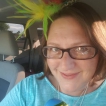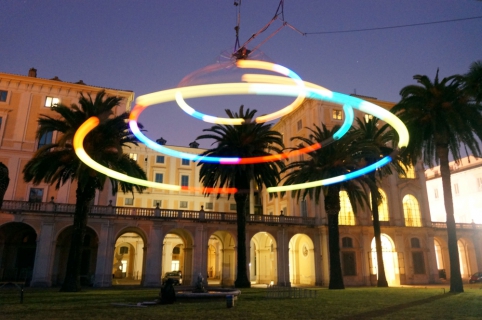Report
BY DANIELA DE PAULIS
- Published: Thursday, March 27 2014 21:24
Can you please describe your latest work, Heaven's Carousel, for the AWB community?
The Heaven's Carousel creates a kind of accelerated sound universe translating light physics into acoustics. It consists of carousel of 12 arms pending at a height of 10 meters. On each arm hangs a double string of seven meters with three loudspeakers on three different levels playing sine waves. When the carousel starts to turn the sine wave frequencies change according to the visitor's position. This is due to the so called Doppler Effect: The pitch is higher if they approach and becomes lower when they disapproach – the same effect you know from an ambulance.
The clue of the Heaven s Carousel is, that the visitors can move under the turning structure. So they discover that in the middle of the installation there is no Doppler Effect at all as the distance to the loudspeakers remains constant. This changes if you slowly move outwards. Then more and more oscillations do appear resulting in an oscillating microtonal sound tapestry.
In fact the installation plays with the idea if we could hear what happens in the night sky: For our eyes the nocturnal sky is a very flat black and white affair. With the help of telescopes we discovered that the celestial objects reveal some colours. But as we have only three colour receptors we get a rather simplified idea of these colours as sum of simply three colour values. This would be very different if we could „hear“ the colours as our ears individual frequencies highly differentiated – in a way our ears are spectroscopic organs.
The Accademia dei Lincei in Rome is the perfect place for presenting your work, because of its tradition in the Arts and Sciences. Do you think the two disciplines are gradually becoming nearer again?
Well, the Heaven's Carousel was presented at the Hubble Space Telescope IV conference which took place at the Accademia de Lincei. The presentation was beautiful in the Palm garden of this oldest academy of the sciences in Europe. But finally it was the collaboration with Hubble which made the project happen. There were also a few academy members who supported the project very much, but I don't see the academy in general at the forefront of the arts and sciences.
What is the perception of your work from the science community? How does it differ from the perception from the art community?
You might address the first question directly to a scientist. All I can say is that I am always surprised and impressed about the deep conceptual discussions I do have with scientists. I am often missing this depth in the arts. This might have to do simply with the factor of time as art curators or journalists do have a limited time budget. But also the reception in the music community is different as they are more open to my formal approach. Also scientists can easily connect to more formal questions. Last but not least most of the scientists and artists do come from practice. As makers we share quite a similar material culture.
images by Tim Otto Roth/ imachination projects and Pam Jeffries/ STScI
visit the project website at: http://www.imachination.net/carousel
My Recent Reports
About Me
Contact
| Location: | Florence, AZ United States of America (the)  |
|---|










Comments